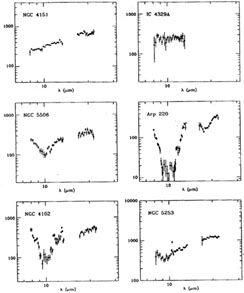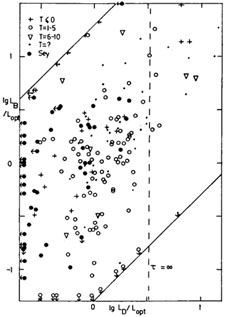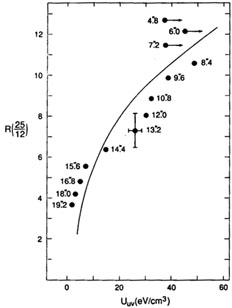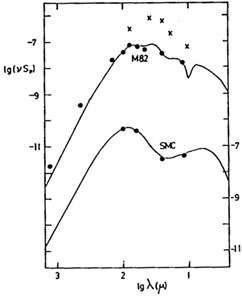


In the past two years several lines of evidence have begun to point towards the destruction of very small grains in regions of very high uv radiation intensity. The most direct evidence comes from infrared spectroscopy. Roche (1988) and Desert and Dennefeld (1988) have shown that the broad 3-12 µ features attributed to very small grains are absent in the spectra of many Seyfert galaxies (Fig 7a). Destruction of very small grains is also presumably the reason that Rowan-Robinson and Crawford (1989) found that the disc component was very weak or absent in many Seyferts (Fig 7b).

|
Figure 7. (a) 8-13µm and 17-22µm spectra of six galaxy nuclei. Note that the unidentified ir features are completely absent from the Seyferts NGC4151 and IC4329A. |

|
Figure 7. (b) Ratio of infrared luminosity in starburst component to optical luminosity, versus ratio of infrared luminosity in cirrus component to optical luminosity for IRAS galaxies (Rowan-Robinson & Crawford 1989). The Seyferts (filled circles) are deficient in the cirrus component. |
Reasonably direct evidence for the destruction of very small grains in a
high radiation
intensity comes from the decline in the ratio of S(12) / S(100) near hot
stars.
Ryter et al (1987)
showed this effect for  Sco and
Boulanger et al
(1988)
showed it for
Sco and
Boulanger et al
(1988)
showed it for  Per.
Per.
Telesco et al (1989)
argue that a similar effect is seen in the center of M82.
Fig 8a
shows the increase in S(25) / S(12) with increasing uv intensity found
by Telesco et
al for M82 superposed on the curve derived from Boulanger
et al's observations of
 Per. However the
spectrum of the emission from outside the nucleus of M82 (and of
the integrated emission from the galaxy) is very similar to that for the
NGC1068
starburst, and for compact Galactic HII regions, shown in
Fig 5b, and one would
normally assume that the bulk of this emission arises in regions where
the visible and
ultraviolet optical depth is >> 1. The 10 µm emission from such a
cloud does not arise
from very small grains. Fig 8b shows the
integrated spectrum of M82 compared to
the optically thick starburst model of
Rowan-Robinson and
Crawford (1989):
the agreement is good. Also shown is the shape of the spectrum of the
central region of M82, derived from the colors measured by
Telesco et al
(1989).
The change in spectrum towards the center of M82 is essentially a shift
of the emission peak from
80 µm to 60 µm, presumably due to the increase in intensity of
the radiation from the
starburst towards to nucleus. It seems unlikely that we are seeing
emission from
optically thin dust (the ratio of Brackett-alpha to -gamma gives a value
for AV of 14 for M82
(Kawara et al 1989) )
and hence the analogy with
Per. However the
spectrum of the emission from outside the nucleus of M82 (and of
the integrated emission from the galaxy) is very similar to that for the
NGC1068
starburst, and for compact Galactic HII regions, shown in
Fig 5b, and one would
normally assume that the bulk of this emission arises in regions where
the visible and
ultraviolet optical depth is >> 1. The 10 µm emission from such a
cloud does not arise
from very small grains. Fig 8b shows the
integrated spectrum of M82 compared to
the optically thick starburst model of
Rowan-Robinson and
Crawford (1989):
the agreement is good. Also shown is the shape of the spectrum of the
central region of M82, derived from the colors measured by
Telesco et al
(1989).
The change in spectrum towards the center of M82 is essentially a shift
of the emission peak from
80 µm to 60 µm, presumably due to the increase in intensity of
the radiation from the
starburst towards to nucleus. It seems unlikely that we are seeing
emission from
optically thin dust (the ratio of Brackett-alpha to -gamma gives a value
for AV of 14 for M82
(Kawara et al 1989) )
and hence the analogy with
 Per appears to be
spurious.
Per appears to be
spurious.

|
Figure 8a. Variation of 25/12 µm color
ratio with intensity of radiation field in center
of M82 (filled circles,
Telesco et al
1989))
compared with relation found in
|

|
Figure 8b. Top: Integrated spectrum of M82 (filled circles) compared with starburst model (data from Telesco 1988, Smith et al 1990a). The crosses (arbitrary vertical scale) show the relative shape of the spectrum of the core of M82. Bottom: Integrated spectrum of the SMC compared with cirrus model (X = 30) in which abundance of 5 Å grains has been reduced by 2/3rds. |
Similarly unconvincing evidence comes from the far infrared colors of
galaxies
(Pajot et al 1986,
Gosh & Drapatz 1987,
Helou 1989).
Here again the problem is
confusion with the role of the optically thick starburst component, for
which, in the model of
Rowan-Robinson and
Crawford (1989),
S(12) / S(60) = 0.04, but
radiative transfer effects in normal 0.01-0.1 µm dust rather than
small grain depletion is the cause.
Fig 4b above showed
Helou's (1989)
compilation of the IRAS
colors of compact Galactic HII regions and of galaxies superposed on the
range of
colors seen in  Per by
Boulanger et al
(1988).
The agreement is good, but in my
view this is fortuitous in the case of Galactic HII regions and galaxies
dominated by
starbursts since in most cases the optical depth in these sources is
high and the
analogy with
Per by
Boulanger et al
(1988).
The agreement is good, but in my
view this is fortuitous in the case of Galactic HII regions and galaxies
dominated by
starbursts since in most cases the optical depth in these sources is
high and the
analogy with  Per
therefore of doubtful significance. If the 60/25 µm color ratio,
ignored by Helou, is also considered, the agreement with
Per
therefore of doubtful significance. If the 60/25 µm color ratio,
ignored by Helou, is also considered, the agreement with
 Per is less impressive.
However the case of the Small Magellanic Cloud
(Schwering 1988)
is convincing because the spectrum of this galaxy does indeed look like
cirrus in which the smallest
grain component is depleted (see Fig 8b).
Per is less impressive.
However the case of the Small Magellanic Cloud
(Schwering 1988)
is convincing because the spectrum of this galaxy does indeed look like
cirrus in which the smallest
grain component is depleted (see Fig 8b).
In an interesting development, Leene and Cox (1987) have found that the 0.22 µ feature is also suppressed in regions of high radiation intensity, which suggests that this feature is associated with the very small carbonaceous grains responsible for the broad features and diffuse emission at 2-20 µ.